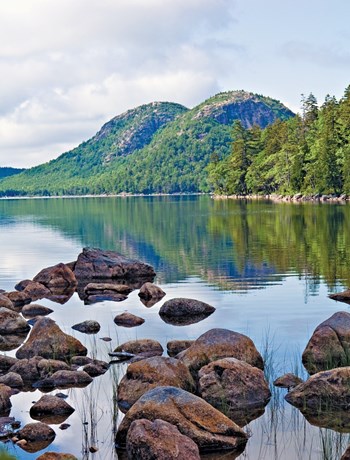
First dubbed “Eden” by settlers at the end of the eighteenth century, Bar Harbor, Maine has always sounded like the quintessential place to vacation. Even the original inhabitants, the Wabanaki Indians, called the area Ah-bays'auk or the “clambake place.” While the style and tone of Bar Harbor has shifted as America matured over the centuries, one thing has remained constant: people voyage to this corner of Maine to relax, eat clams and bask in some of the most gorgeous scenery in New England.
The town of Bar Harbor sits on the eastern side of Mount Desert Island – the largest island in Maine. With over 100 square miles, Mount Desert is the second largest island on the East Coast, surpassed only by Long Island. Mount Desert was given its name in 1604, which roughly translates “island of bare mountains,” in recognition of rocky Cadillac Mountain which dominates the island. Because of its location between the French-controlled areas to its North and the increasingly English-controlled areas to the South, Mount Desert remained disputed territory and largely unsettledfor the next 150 years.
With the British victory in the French and Indian War in 1763, the British finally succeeded in overpowering the French and assumed control of “New France,” including the rocky coast of Maine and the island of Mount Desert. Bar Harbor was first incorporated as “Eden” in 1796. Despite the utopian setting, the name was chosen to honor an Englishman named Richard Eden. By the time Maine achieved statehood in 1820, there were a thousand hardy residents living on the island, most of whom made a living from farming, fishing, lumbering or quarrying. It did not take long, however, for Bar Harbor to switch from a town of farmers and fishermen to a town of innkeepers.
Landscape Artists and “Rusticators”
In the middle of the 19th century, members of the Hudson River School of artists, including Thomas Cole and Frederic Edwin Church, came and painted romantic landscapes of Bar Harbor and the island. When the artists exhibited their works in large cities, thepaintings inadvertently served as Bar Harbor’s first promotional campaign and fans made their way to Maine to experience the beauty firsthand.
Early lodging was entirely informal and required bunking with local fishermen and farmers. Bar Harbor quickly became the place to be and the need for housing grew. The Bar Harbor Historical Society cites the Agamont House, built in 1855, as the first hotel in town and “Birch Point,” built in 1868, as the first documented summerestate.
By 1880 tourism had become the largest industry in Bar Harbor and on the island. Early tourists, deemed “rusticators,” had come with a desire to rough it in the natural landscape. By the end of the 19th century, the rich and famous had arrived with very different vacation expectations.
Fortunes and Fire
America experienced a burst of wealth at the end of the 19th century and a new era of guests flocked to Bar Harbor, launching the town’s gilded age. In 1875, David Rodick was the first to respond to the rapid popularity growth with the “Rodick House,” a shockingly large hotel for the area, ableto accommodate 275 guests. Demand still outstripped supply, and five years later Rodick expanded his hotel to accommodate 400 guests. Soon after, luxurious private homes became the fashion when the country’s most prominent families, including the Vanderbilts, Carnegies, Astors and Rockefellers, created a community of summer “cottages,” structures more aptly called mansions. Luxury and opulence set the tone in Bar Harbor for several decades. The decline of the resort’s gilded age began with the Great Depression, was furthered by World War II and was finalized by a catastrophic fire in 1947.
In the fall of 1947, a fire flared in a cranberry bog outside of town. Over aperiod of two weeks, 17,000 acres of forests, most of the large hotels and many of the grand summer homes were consumed by flames. The era of opulence was over. Once again the primary draw of Bar Harbor was the simple rugged beauty of the Maine Coast and Cadillac Mountain.
Acadia National Park
Although many gilded age buildings were destroyed by the great fire, the wealth that flowed into Bar Harbor at the turn of the century left a far more meaningful mark on the island. George Dorr, one of the prominent visitors, was instrumental in establishing Acadia National Park, arguably one of the most beautiful parks in America, which covers most of MountDesert Island.
Dorr spent the better part of his adult life and a good bit of his fortuneattempting to preserve the beauty of Mount Desert Island. Dorr successfully acquired thousands of acres of land on the island at the beginning of the 20th century, transferred the land to the federal government during the Wilson Administration, and thus created the first national park east of the Mississippi River.
Today, Acadia National Park stretches over 47,000 acres. It contains Cadillac Mountain, the highest mountain on the east coast (at 1,532 feet). With granite cliffs carved by glaciers, 120 miles of hiking trails, forests, lakesand streams, as well as the only fjord in the eastern United States, Acadia draws between two and three million visitors annually.
As Tony Cameron, Director of Marketing & Membership Sales of the Bar Harbor Chamber of Commerce explains, “It is what makes Bar Harborand Mount Desert Island truly special and different from other coastal communities: we have mountains that meet the ocean. We have a huge range on the island: lakes, ponds, forests, beaches, mountains and coastline.”
Despite being on an island with thousands of acres of wilderness, Bar Harbor is very accessible. A little over 250 miles from Boston, and not far off of Interstate 95, the town is easily reached by car. Bar Harbor is also a true harbor and a well-known boating town, there are moorings available for all types of crafts, from the smallest sailboat to the 70 large cruise ships that dock each year.
While guests come from everywhere in the world, Cameron notes that the majority hail from Boston, New York, or the mid-Atlantic. Cameron adds that despite the recent economy, Bar Harbor and Acadia continue to draw visitors from every demographic. “Bar Harbor does have some upscale parts, but also camping, family-friendly and low-key lodging. There really is something for everyone.”
Population Booms in Summer
The largest of the four towns on the Mount Desert Island, Bar Harbor has a year-round population of around 5,000 residents, a summer population of over 20,000, and serves as jumping-offplace for many of the millions of visitors who come to Acadia National Park every year. As local realtor Jeffrey Miller of Lynam Real Estate explains, “It is like living in two places at once. It is a bustling resort town in the summer with visitors from all over. And then when the summer visitors leave, it is a little quiet town where it can take an hour to buy a loaf of bread because you stop to catch up with everyone in the store. ”
Most businesses cater to tourists and summer residents, notably art galleries, restaurants, outdoor shops and lodging. However, there is another game in town, and that involves mice. Bar Harbor is the headquarters of The Jackson Laboratory, a nonprofit research lab that focuses on genetics research through the study of mice to advance human health. “Most people don’t realize that the largest employer in Bar Harbor has nothing to do with tourism,” explains Cameron. The Jackson Laboratory is home to 38 biomedical research teams and 4,000 varieties of laboratory mice.
Vacation Homes Dominate
Real estate in Bar Harbor centers largely on the vacation, retirement and second home market. According to Miller, nearly 65% of their housingsales are vacation or second homes.
While there is definitely a high end in the housing market with homes over a million dollars, most properties sell in the $250,000-$350,000 range. Miller explains that, until a few years ago when several small complexes werebuilt, condominiums were relatively rare in Bar Harbor.
The new condominiums have not sold well. According to the Bar Harbor Assessor’s office, of the 36 residential properties that sold in 2009, only one was a condominium. The sale prices of residences sold in 2009 ranged from$142,000 to $3.9 million, with a median price of $270,000.
Surrounded by Acadia National Park, Bar Harbor has been a coveted vacation destination for over a hundred years. A small town with a really big guest list, tourists continue to come tothis resort town for the same reasons that drew the first “rusticators”: a relaxed and welcoming town situated between the rocks of the Maine coast and the mountains of Acadia.
Sarah Sanford is a freelance writer and a frequent contributor to New England Condominium magazine.






Leave a Comment